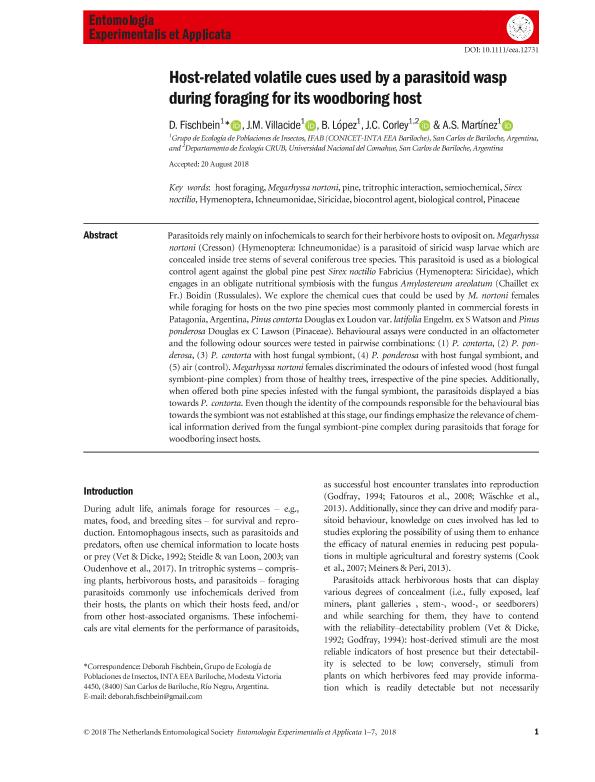Mostrar el registro sencillo del ítem
dc.contributor.author
Fischbein, Deborah

dc.contributor.author
Villacide, José María

dc.contributor.author
Lopéz, B.
dc.contributor.author
Corley, Juan Carlos

dc.contributor.author
Martinez Von Ellrichshausen, Andres Santiago

dc.date.available
2020-04-07T18:05:28Z
dc.date.issued
2018-10-20
dc.identifier.citation
Fischbein, Deborah; Villacide, José María; Lopéz, B.; Corley, Juan Carlos; Martinez Von Ellrichshausen, Andres Santiago; Host-related volatile cues used by a parasitoid wasp during foraging for its woodboring host; Wiley Blackwell Publishing, Inc; Entomologia Experimentalis et Applicata; 166; 11; 20-10-2018; 907-913
dc.identifier.issn
0013-8703
dc.identifier.uri
http://hdl.handle.net/11336/102193
dc.description.abstract
Parasitoids relymainly on infochemicals to search for their herbivore hosts to oviposit on. Megarhyssanortoni (Cresson) (Hymenoptera: Ichneumonidae) is a parasitoid of siricid wasp larvae which areconcealed inside tree stems of several coniferous tree species. This parasitoid is used as a biologicalcontrol agent against the global pine pest Sirex noctilio Fabricius (Hymenoptera: Siricidae), whichengages in an obligate nutritional symbiosis with the fungus Amylostereum areolatum (Chaillet exFr.) Boidin (Russulales). We explore the chemical cues that could be used by M. nortoni femaleswhile foraging for hosts on the two pine species most commonly planted in commercial forests inPatagonia, Argentina, Pinus contorta Douglas ex Loudon var. latifolia Engelm. ex SWatson and Pinusponderosa Douglas ex C Lawson (Pinaceae). Behavioural assays were conducted in an olfactometerand the following odour sources were tested in pairwise combinations: (1) P. contorta, (2) P. ponderosa,(3) P. contorta with host fungal symbiont, (4) P. ponderosa with host fungal symbiont, and(5) air (control). Megarhyssa nortoni females discriminated the odours of infested wood (host fungalsymbiont-pine complex) from those of healthy trees, irrespective of the pine species. Additionally,when offered both pine species infested with the fungal symbiont, the parasitoids displayed a biastowards P. contorta. Even though the identity of the compounds responsible for the behavioural biastowards the symbiont was not established at this stage, our findings emphasize the relevance of chemicalinformation derived from the fungal symbiont-pine complex during parasitoids that forage forwoodboring insect hosts.
dc.format
application/pdf
dc.language.iso
eng
dc.publisher
Wiley Blackwell Publishing, Inc

dc.rights
info:eu-repo/semantics/openAccess
dc.rights.uri
https://creativecommons.org/licenses/by-nc-sa/2.5/ar/
dc.subject
BIOCONTROL AGENT
dc.subject
BIOLOGICAL CONTROL
dc.subject
HOST FORAGING
dc.subject
HYMENOPTERA
dc.subject
ICHNEUMONIDAE
dc.subject
MEGARHYSSA NORTONI
dc.subject
PINACEAE
dc.subject
PINE
dc.subject
SEMIOCHEMICAL
dc.subject
SIREX NOCTILIO
dc.subject
SIRICIDAE
dc.subject
TRITROPHIC INTERACTION
dc.subject.classification
Ecología

dc.subject.classification
Ciencias Biológicas

dc.subject.classification
CIENCIAS NATURALES Y EXACTAS

dc.title
Host-related volatile cues used by a parasitoid wasp during foraging for its woodboring host
dc.type
info:eu-repo/semantics/article
dc.type
info:ar-repo/semantics/artículo
dc.type
info:eu-repo/semantics/publishedVersion
dc.date.updated
2019-10-15T17:53:54Z
dc.journal.volume
166
dc.journal.number
11
dc.journal.pagination
907-913
dc.journal.pais
Reino Unido

dc.journal.ciudad
Londres
dc.description.fil
Fil: Fischbein, Deborah. Instituto Nacional de Tecnología Agropecuaria. Centro Regional Patagonia Norte. Estación Experimental Agropecuaria San Carlos de Bariloche. Instituto de Investigaciones Forestales y Agropecuarias Bariloche. - Consejo Nacional de Investigaciones Científicas y Técnicas. Centro Científico Tecnológico Conicet - Patagonia Norte. Instituto de Investigaciones Forestales y Agropecuarias Bariloche; Argentina
dc.description.fil
Fil: Villacide, José María. Instituto Nacional de Tecnología Agropecuaria. Centro Regional Patagonia Norte. Estación Experimental Agropecuaria San Carlos de Bariloche. Instituto de Investigaciones Forestales y Agropecuarias Bariloche. - Consejo Nacional de Investigaciones Científicas y Técnicas. Centro Científico Tecnológico Conicet - Patagonia Norte. Instituto de Investigaciones Forestales y Agropecuarias Bariloche; Argentina
dc.description.fil
Fil: Lopéz, B.. Instituto Nacional de Tecnología Agropecuaria. Centro Regional Patagonia Norte. Estación Experimental Agropecuaria San Carlos de Bariloche. Instituto de Investigaciones Forestales y Agropecuarias Bariloche. - Consejo Nacional de Investigaciones Científicas y Técnicas. Centro Científico Tecnológico Conicet - Patagonia Norte. Instituto de Investigaciones Forestales y Agropecuarias Bariloche; Argentina
dc.description.fil
Fil: Corley, Juan Carlos. Instituto Nacional de Tecnología Agropecuaria. Centro Regional Patagonia Norte. Estación Experimental Agropecuaria San Carlos de Bariloche. Instituto de Investigaciones Forestales y Agropecuarias Bariloche. - Consejo Nacional de Investigaciones Científicas y Técnicas. Centro Científico Tecnológico Conicet - Patagonia Norte. Instituto de Investigaciones Forestales y Agropecuarias Bariloche; Argentina. Universidad Nacional del Comahue. Centro Regional Universitario Bariloche; Argentina
dc.description.fil
Fil: Martinez Von Ellrichshausen, Andres Santiago. Instituto Nacional de Tecnología Agropecuaria. Centro Regional Patagonia Norte. Estación Experimental Agropecuaria San Carlos de Bariloche. Instituto de Investigaciones Forestales y Agropecuarias Bariloche. - Consejo Nacional de Investigaciones Científicas y Técnicas. Centro Científico Tecnológico Conicet - Patagonia Norte. Instituto de Investigaciones Forestales y Agropecuarias Bariloche; Argentina
dc.journal.title
Entomologia Experimentalis et Applicata

dc.relation.alternativeid
info:eu-repo/semantics/altIdentifier/url/https://onlinelibrary.wiley.com/doi/full/10.1111/eea.12731
dc.relation.alternativeid
info:eu-repo/semantics/altIdentifier/doi/http://dx.doi.org/10.1111/eea.12731
Archivos asociados
